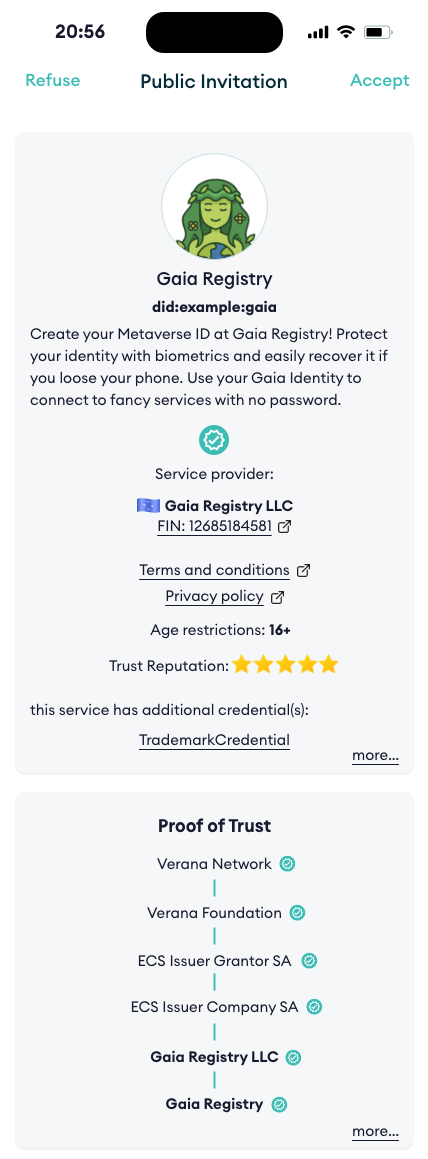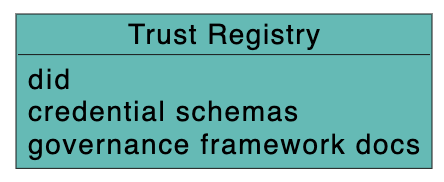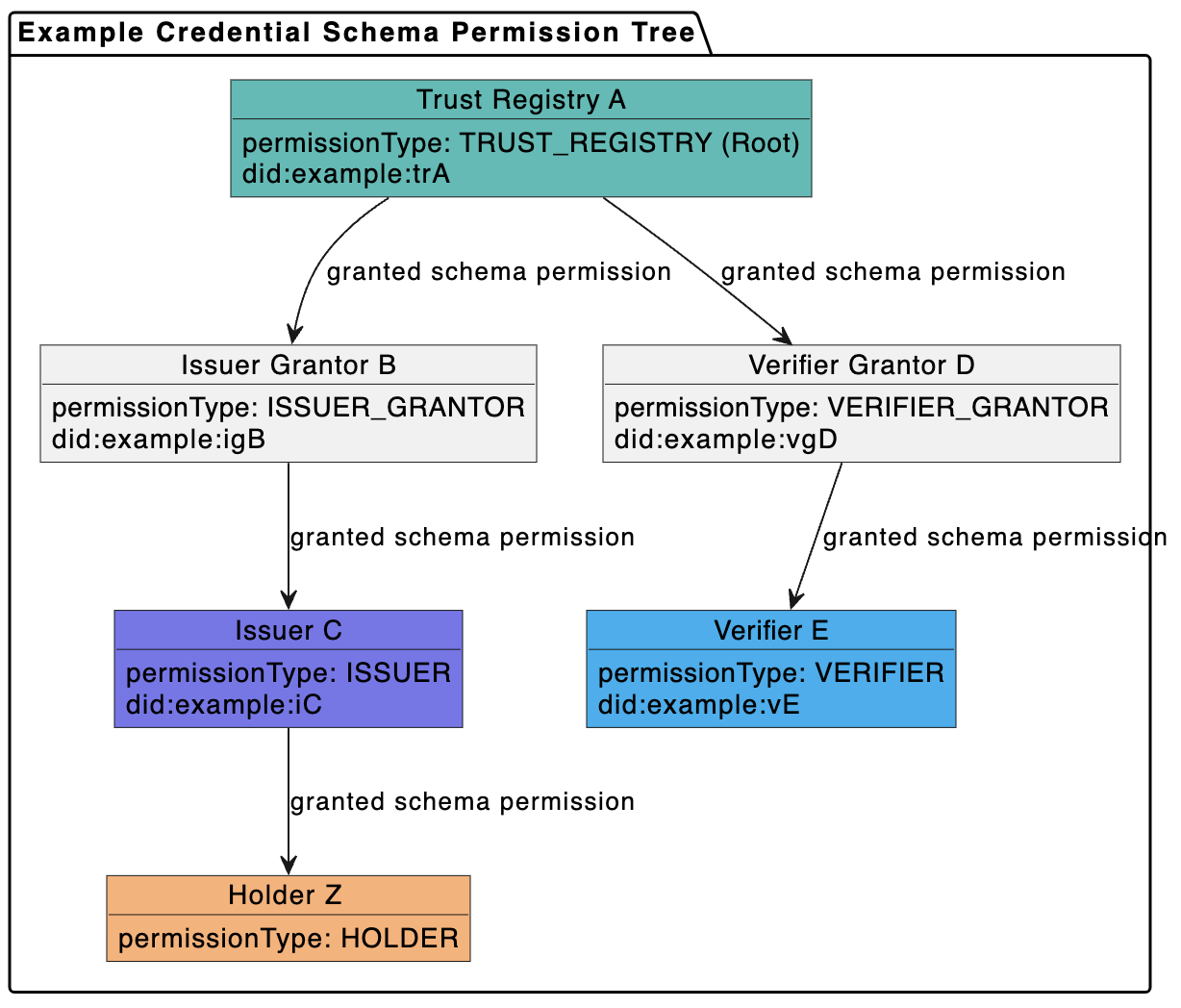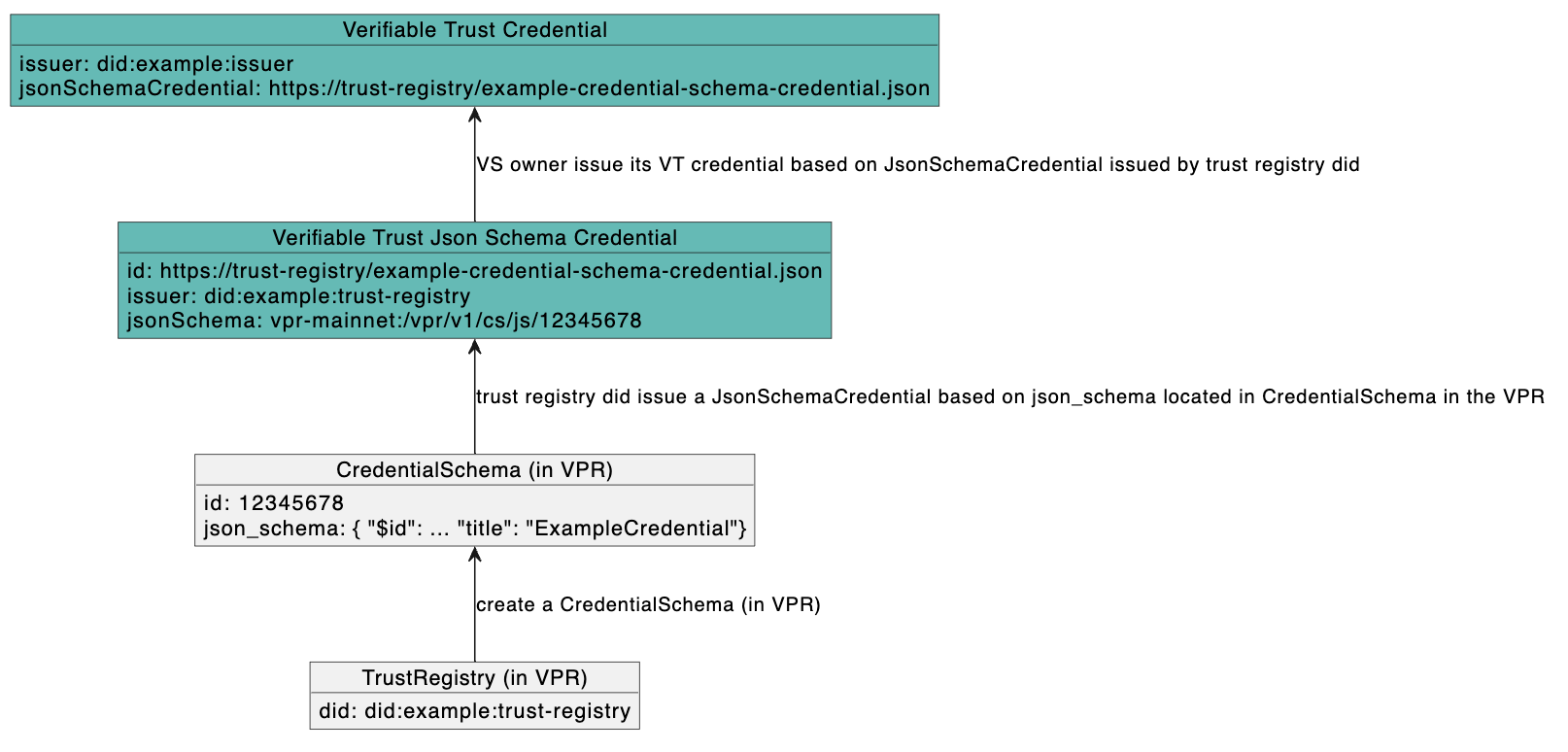Understanding Verifiable Trust

Trust Resolution is as simple as calling a method passing the DID of the service we want to resolve, to display a Proof-of-Trust to the end-user:
resolve_trust("did:example:gaia")
and receive a response similar to this one:
{
"did":"did:example:gaia",
"verified": true,
"service_provider": {
"id": "did:example:def",
"type": "Organization",
"name": "Gaia Registry LLC",
"country": "zz",
"reputation": {
"issuedCredentials": 1234,
"verifiedCredentials": 7678,
"trustDepositValue": 176327.124356,
"amountSlashed": 0,
"stars": 5.0
},
"issuer": "did:example:zzz",
...
},
"service": {
"name": "Gaia Registry",
"termsAndConditions": "http://example.com",
"privacyPolicy": "http://example.com",
"minimumAgeRequired": 16,
"description": "Create your Metaverse ID at Gaia Registry! Protect your identity with biometrics and easily recover it if you loose your phone. Use your Gaia Identity to connect to fancy services with no password."
...
},
"credentials" : [
{
"type": "TrademarkCredential",
...
}
]
...
}
Deep Dive into Verifiable Trust
Let’s explain how the Verifiable Trust does it.

Verifiable Trust (VT) introduces 3 main concepts:
- Verifiable Service (VS),
- Verifiable User Agent (VUA), and
- Verifiable Public Registry (VPR).
What is a Verifiable Service (VS)?
A VS is a service that provides a way to identify itself to a peer, before the peer connects to it.
Entities that want to connect to a VS can review its presented verifiable credentials, prove their legitimacy by performing a trust resolution, and based on the result, decide to connect or not.
A VS must resolve trust of peers that attempt to connect to it (VS and/or VUA) and refuse connections from non-verifiable peers.
Additionally, a verifiable service that would like to issue or request verification of credentials, must prove it is allowed to do so, else peer must refuse that action.
What is a Verifiable User Agent (VUA)?
A Verifiable User Agent (VUA) is a software (a browser, an app, a wallet…) for connecting to VSs and other VUAs. When establishing connections, a VUA must verify the connection peer(s) and allow connection(s) only to compliant VS and VUA peers.
Additionally, VUAs must perform a trust resolution by verifying the credentials presented by the peers and query VPR(s) to check that these credentials have been issued by verified issuers.
What is a Verifiable Public Registry (VPR)?
A Verifiable Public Registry (VPR) is a “registry of registries”, a public service that provides foundational infrastructure for decentralized trust ecosystems. It offers:
Trust Registry Management:
Ecosystems can create and manage their own Trust Registries, each with:- Defined Credential Schemas
- Assigned roles for Issuers, Verifiers, and Grantors
- Custom business models and permission policies
Query API for Trust Resolution:
A standardized API used by Verifiable Services (VSs) and Verifiable User Agents (VUAs) to perform trust resolution, enabling them to query registry data and validate roles and permissions in real time.

Trust Registries
Each Ecosystem Trust Registry is uniquely identified by a resolvable DID and must provide, at a minimum:
- One or more Governance Framework document(s)
- Zero or more Credential Schemas
The Verifiable Public Registry (VPR) is agnostic to the specific DID methods used. Trust resolution is performed externally, outside the VPR, allowing flexibility and interoperability across ecosystems.

Credential Schemas
Credential Schemas are created and managed by Trust Registry owners (Ecosystems). Each Credential Schema includes, at a minimum:
- A JSON Schema that defines the structure of the corresponding Verifiable Credential
- A PermissionManagementMode for issuance policy, which determines how
Issuerpermissions are granted. Modes include:OPEN: Anyone can become an IssuerTRUST_REGISTRY: Permissions are granted directly by the Trust Registry controllerGRANTOR_VALIDATION: Permissions are granted by anIssuer Grantorafter a validation process
- A PermissionManagementMode for verification policy, which determines how
Verifierpermissions are granted. Modes include:OPEN: Anyone can act as a VerifierTRUST_REGISTRY: Permissions are granted directly by the Trust Registry controllerGRANTOR_VALIDATION: Permissions are granted by aVerifier Grantorafter a validation process
- A Permission Tree that defines the roles and relationships involved in managing the schema’s lifecycle.

Participant roles are defined in the table below:
| Participant Role | Description |
|---|---|
| Trust Registry | Create and control Credential Schemas. Grant other roles. |
| Issuer Grantor | Grant Issuer permissions to candidate issuers. |
| Verifier Grantor | Grant Verifier permissions to candidate verifiers. |
| Issuer | Can issue credentials of this schema. |
| Verifier | Can request presentation of credentials of this schema. |
| Holder | Special role used for selected business models. |
Example of a Json Schema credential schema:
{
"$id": "vpr-mainnet:/vpr/v1/cs/js/VPR_CREDENTIAL_SCHEMA_ID",
"$schema": "https://json-schema.org/draft/2020-12/schema",
"title": "SimpleExampleCredential",
"description": "SimpleExampleCredential using JsonSchema",
"type": "object",
"properties": {
"credentialSubject": {
"type": "object",
"properties": {
"id": {
"type": "string",
"format": "uri"
},
"firstName": {
"type": "string",
"minLength": 0,
"maxLength": 256
},
"lastName": {
"type": "string",
"minLength": 1,
"maxLength": 256
},
"expirationDate": {
"type": "string",
"format": "date"
},
"countryOfResidence": {
"type": "string",
"minLength": 2,
"maxLength": 2
}
},
"required": [
"id",
"lastName",
"birthDate",
"expirationDate",
"countryOfResidence"
]
}
}
}
After creating the JSON Schema, the Ecosystem owner of the Trust Registry issues a JSON Schema Credential using the DID registered as the Trust Registry’s identifier in the VPR.
This credential serves as a verifiable proof of:
- Ownership of the Credential Schema
- Control over the corresponding Trust Registry DID.
{
"@context": [
"https://www.w3.org/ns/credentials/v2"
],
"id": "https://trust-registry/example-credential-json-schema-credential.json",
"type": ["VerifiableCredential", "JsonSchemaCredential"],
"issuer": "did:example:trust-registry",
"issuanceDate": "2024-01-01T19:23:24Z",
"credentialSchema": {
"id": "https://w3c.github.io/vc-json-schema/schema/json-schema-credential-schema.json",
"type": "JsonSchema",
"digestSRI": "sha384-S57yQDg1MTzF56Oi9DbSQ14u7jBy0RDdx0YbeV7shwhCS88G8SCXeFq82PafhCrW"
},
"credentialSubject": {
"id": "vpr-mainnet:/vpr/v1/cs/js/12345678",
"type": "JsonSchema",
"jsonSchema": {
"$ref": "vpr-mainnet:/vpr/v1/cs/js/12345678"
},
"digestSRI": "sha384-ABCSGyugst67rs67rdbugsy0RDdx0YbeV7shwhCS88G8SCXeFq82PafhCeZ"
}
}
Finally, the Ecosystem must publish both the JSON Schema Credential and the location of the Trust Registry within the DID Document associated with the declared Trust Registry DID in the VPR.
This ensures that the Credential Schema and its controlling Trust Registry are publicly discoverable and cryptographically verifiable.
"service": [
{
"id": "did:example:trust-registry#vpr-schemas-example-credential-schema-credential",
"type": "LinkedVerifiablePresentation",
"serviceEndpoint": ["https://trust-registry/example-credential-schema-presentation.json"]
},
{
"id": "did:example:trust-registry#vpr-schemas-trust-registry-1234",
"type": "VerifiablePublicRegistry",
"version": "1.0",
"serviceEndpoint": ["vpr-mainnet:/vpr/v1/"]
}
...
]
Issue Verifiable Credentials
Once the Ecosystem has:
- Created its Credential Schemas in the VPR
- Issued the corresponding JSON Schema Credentials
- Properly configured the
"service"section of its Trust Registry DID Document
…it is now possible to issue Verifiable Credentials based on these schemas.
Credentials that comply with the Verifiable Trust Specification are referred to as Verifiable Trust Credentials. These credentials must include, in their credentialSchema attribute, a reference to the corresponding JSON Schema Credential issued by the Trust Registry DID. This linkage ensures cryptographic proof of the schema’s origin and trustworthiness.
In our previous example, that would mean and ExampleCredential should look like this example:
{
"@context": [
"https://www.w3.org/ns/credentials/v2"
],
"id": "did:example:issuer",
"type": ["VerifiableCredential", "VerifiableTrustCredential", "ExampleCredential"],
"issuer": "did:example:issuer",
"credentialSubject": {
"id": "did:example:abcdef",
...
},
...
"credentialSchema": {
"id": "https://trust-registry/example-credential-json-schema-credential.json",
"type": "JsonSchemaCredential"
}
}
We can summarize the dependencies, from trust registry created in VPR, until issued credential.
